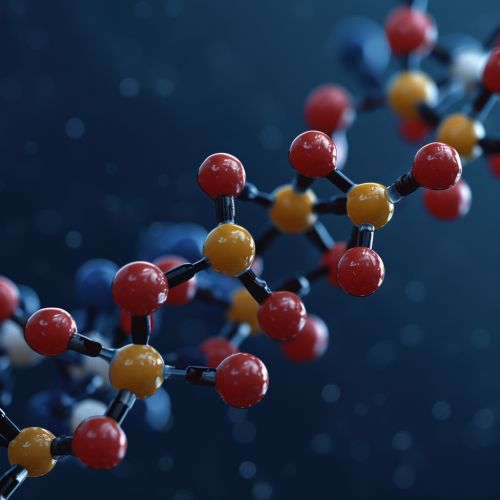Isopentenyl pyrophosphate
Introduction
Isopentenyl pyrophosphate (IPP) is a crucial intermediate in the biosynthesis of isoprenoids, the most diverse class of metabolites in nature. It is a five-carbon compound that serves as the building block for thousands of isoprenoid compounds found in all classes of living organisms. This article delves into the structure, biosynthesis, and biological significance of IPP, as well as its role in various metabolic pathways.
Structure
IPP is a five-carbon compound with a pyrophosphate group attached to the end of the molecule. The molecule is highly reactive due to the presence of the pyrophosphate group, which can be readily cleaved to provide energy for subsequent reactions. The structure of IPP is derived from the five-carbon sugar, ribose, and the molecule can exist in two isomeric forms: the more common isopentenyl pyrophosphate and its less common isomer, dimethylallyl pyrophosphate (DMAPP).
Biosynthesis
IPP is synthesized in cells through two distinct pathways: the mevalonate pathway and the non-mevalonate, or MEP pathway. Both pathways are used by different organisms, and in some cases, both pathways are present in the same organism.
Mevalonate Pathway
The mevalonate pathway of IPP biosynthesis is found in animals, fungi, and some bacteria. This pathway begins with the condensation of two molecules of acetyl-CoA, followed by a series of reduction and dehydration reactions to form mevalonate. Mevalonate is then phosphorylated twice by mevalonate kinase and phosphomevalonate kinase, respectively. Finally, mevalonate diphosphate decarboxylase catalyzes the decarboxylation of mevalonate diphosphate to yield IPP.
MEP Pathway
The MEP pathway, also known as the non-mevalonate pathway, is found in most bacteria, algae, and plants. This pathway begins with the condensation of glyceraldehyde 3-phosphate and pyruvate to form 1-deoxy-D-xylulose 5-phosphate (DXP). DXP is then converted to MEP through a series of reactions catalyzed by DXP reductoisomerase and other enzymes. MEP is then converted to IPP and DMAPP through a series of reactions involving several enzymes, including MEP cytidylyltransferase, 4-diphosphocytidyl-2C-methyl-D-erythritol kinase, 2C-methyl-D-erythritol 2,4-cyclodiphosphate synthase, and finally, IPP/DMAPP synthase.
Biological Significance
IPP is the precursor to all isoprenoids, a large and diverse group of compounds that includes sterols, carotenoids, prenylated proteins, and many others. These compounds play a wide range of roles in cellular processes, from structural components of cell membranes (e.g., sterols) to signaling molecules (e.g., prenylated proteins) and pigments (e.g., carotenoids).
In addition, IPP is also a precursor to the side chains of ubiquinone and plastoquinone, which are essential components of the electron transport chain in mitochondria and chloroplasts, respectively. Thus, IPP is crucial for energy production in cells.
IPP also plays a role in the immune response. Certain immune cells, such as gamma delta T cells, can recognize IPP and other prenyl pyrophosphates. This recognition can lead to the activation of these immune cells, which can then mount an immune response against pathogens.
Role in Metabolic Pathways
IPP is involved in several metabolic pathways, including the biosynthesis of terpenes, steroids, and other isoprenoids. These pathways are crucial for the production of a wide range of biologically active compounds.
Terpene Biosynthesis
In the biosynthesis of terpenes, IPP and its isomer, DMAPP, are condensed to form geranyl pyrophosphate, a ten-carbon compound. This reaction is catalyzed by the enzyme geranyl pyrophosphate synthase. Geranyl pyrophosphate can be further condensed with another molecule of IPP to form farnesyl pyrophosphate, a fifteen-carbon compound, in a reaction catalyzed by farnesyl pyrophosphate synthase. Farnesyl pyrophosphate can then be used to synthesize various terpenes and terpenoids.
Steroid Biosynthesis
In the biosynthesis of steroids, IPP is used to form squalene, a thirty-carbon compound. This is achieved by the condensation of two molecules of farnesyl pyrophosphate, followed by a series of reduction and cyclization reactions to form lanosterol, the precursor to all steroids.
Other Isoprenoid Biosynthesis
IPP is also involved in the biosynthesis of other isoprenoids, such as dolichols, ubiquinones, and prenylated proteins. These compounds play various roles in cellular processes, from protein glycosylation (dolichols) to electron transport (ubiquinones) and signal transduction (prenylated proteins).


